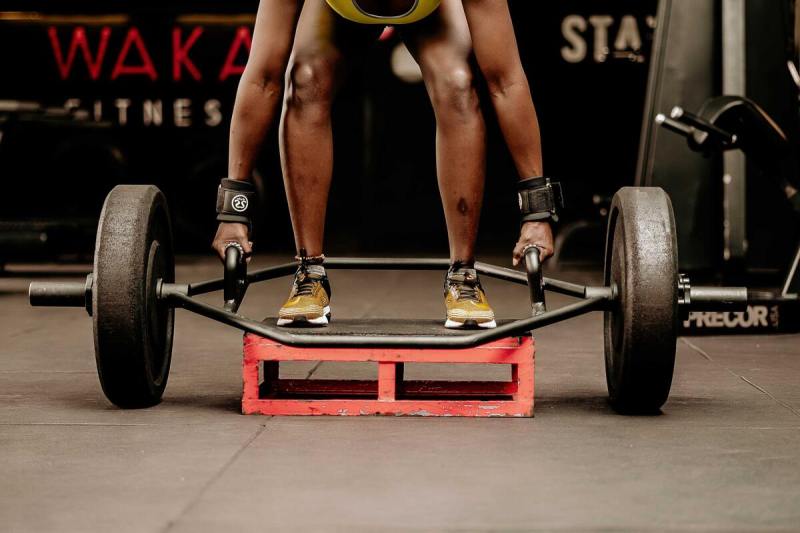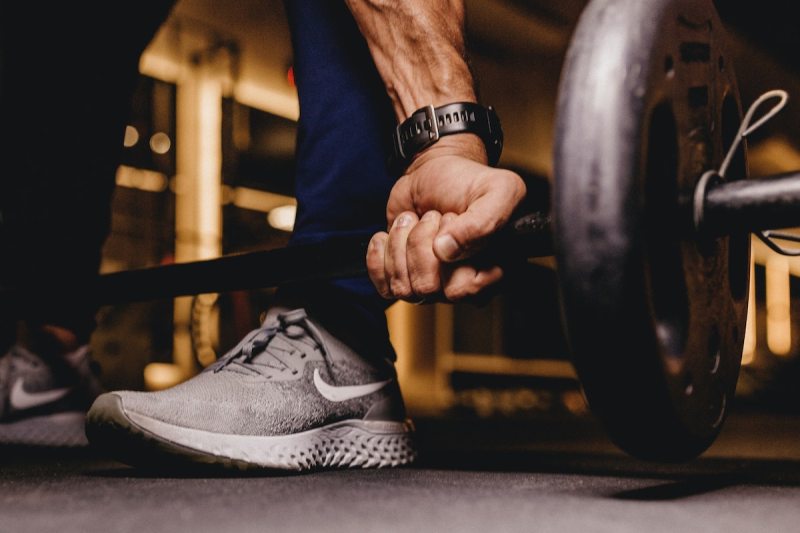Most people have heard of the deadlift, tried it before, or seen others deadlift in the gym. The traditional deadlift involves using the straight barbell, and barbell purists strongly believe this is the ultimate and original way to perform the deadlift.
That being said, the trap bar deadlift is a highly underrated version that provides plenty of benefits and might be a better choice for some people. The trap bar allows for more flexibility and can be a safer and easier option for many people to start with. Let’s look at the trap bar deadlift, the difference between the trap bar and the original, the benefits of this version, and more.
What’s the difference between the deadlift and the trap bar deadlift?

The trap bar deadlift is a variation of the original deadlift where you lift a specialty barbell shaped like a hexagon. This full-body exercise might also be called the hex bar deadlift. When performing the trap bar deadlift, you step inside the middle of the hexagon of the specialty barbell and lift the weight around you. You can hold on to the handles on either side with a neutral grip. With the original deadlift, you use a straight barbell.
The trap bar is a functional way to perform the deadlift that shifts your grip more toward the side of your body rather than the front. When you naturally lift heavier objects in your day-to-day life, you probably lift more from the sides, as you would with a trap bar deadlift, rather than directly in front of you. Consider this when you next go to lift a heavier bag of groceries.
Is a trap bar deadlift just a squat?

Some people argue that the trap bar deadlift is more of a squat than a true “hinge” movement and that it isn’t as effective because it won’t train the hinge pattern optimally. This is a myth, and the trap bar deadlift is certainly nowhere close to a squat.
While you are in more of a squat position for the trap bar deadlift compared to the original deadlift, it still isn’t a true squat. It’s more of a squat/hinge hybrid that’s actually closer to a “hinge” movement. The trap bar deadlift emphasizes your hip extensors more than your quads, and the joint ranges of motion are almost identical for the conventional deadlift and the trap bar deadlift.
What muscles does the trap bar deadlift work?

Both the conventional and trap bar deadlifts provide a similar degree of muscle activation. However, the quad activation is a little more amplified for the trap bar deadlift. The trap bar deadlift works the following muscles:
- Quads
- Hamstrings
- Glutes
- Lower back
- Upper back
- Lats
- Core
- Forearms
What are the benefits of the trap bar deadlift?

The trap bar deadlift is a superior exercise that provides plenty of benefits, including:
- Developing your total-body strength
- Building a larger back
- Enhancing your overall athletic performance and explosive power
- Excellent choice for beginners as an entry-level deadlift practice
- Increasing your lower body strength
- Putting less strain on your lower back and lumbar area compared to traditional deadlifts
Possible drawbacks of the trap bar deadlift

Overall, the trap bar deadlift is a worthwhile exercise, but for some people, there could be possible drawbacks, such as:
- It isn’t used in competitions, so powerlifters often prefer the conventional deadlift to practice.
- Straight barbell deadlifts are widely used in sports.
- The trap bar handles are set up for the average-sized man or even larger men with some heavy-duty trap bars. Some people might find that the handles are wider than what’s comfortable for lifting.
- A study showed that there was significantly more hamstring muscle activation through the top half of the movement during the conventional deadlift compared to the trap bar deadlift.
How to do the trap bar deadlift

How to do the trap bar deadlift:
- Stand in the middle of the trap bar with your feet a little wider than shoulders-distance apart. Bend your hips and knees.
- Reach down to hold the handles of the trap bar.
- Keep a firm, neutral grip on the handles and squeeze your shoulder blades together.
- Keep your back flat and your chest up.
- Push through your heels to stand straight up and lift the trap bar.
- At the peak of the position, you should be standing straight with your arms down by your sides, holding the trap bar.
- Pause for just a moment.
- Carefully lower the trap bar down to the starting position by bending your knees and hinging at your hips.
Tips to master your technique

The following are top tips to master your technique to get the most out of this exercise:
- Stand in the center of the trap bar.
- Focus on something directly in front of you to help keep your head in a neutral position.
- Make sure your hips are lower than your shoulders to prepare for the deadlift.
- Engage your core.
- Squeeze your glutes and pause for a moment at the peak of the movement.
- Lower the trap bar slowly back down to the ground with control.
How much weight should you lift for the trap bar deadlift?

How much weight you should lift depends on your overall fitness level, your goals, and other individual factors. Because the weight is at your sides during the hex trap bar deadlift, you’ll find you can lift more weight compared to the straight bar while also reducing your risk of a lower back injury.
More total weight ramps up muscle growth. Always make sure the weight is challenging but doesn’t compromise your form for optimal safety and results.
Common mistakes to avoid

These are the most common mistakes to avoid when performing the trap bar deadlift:
- Knees caving in toward each other
- Rounding your back
- Improper grip
- Looking up and putting unnecessary tension on your neck
How to include the trap bar deadlift in your workouts

If you’re a beginner, start with 2 or 3 sets of 6 to 10 reps using a lighter weight. Make sure you’re resting for 2 or 3 minutes between sets. If you’re looking for a heavy strength workout, shoot for 5 sets of 5 reps or 6 sets of 4 reps with a heavier weight that’s around 85% to 90% of your 1-rep max.
The bottom line is that if you specifically want to emphasize your hamstrings or work your way up to a powerlifting competition, you might decide to practice with the conventional deadlift. If you’re a beginner and you want to work on your balance and strength over time, the trap bar deadlift might be the better choice. Many athletes and advanced weightlifters still use the trap bar because it offers plenty of benefits and you can put less strain on your lower back while still pumping up the same muscle groups. The trap bar deadlift allows for high-volume deadlift work and slightly heavier loading. The overall movement pattern is similar to the old-fashioned deadlift.




